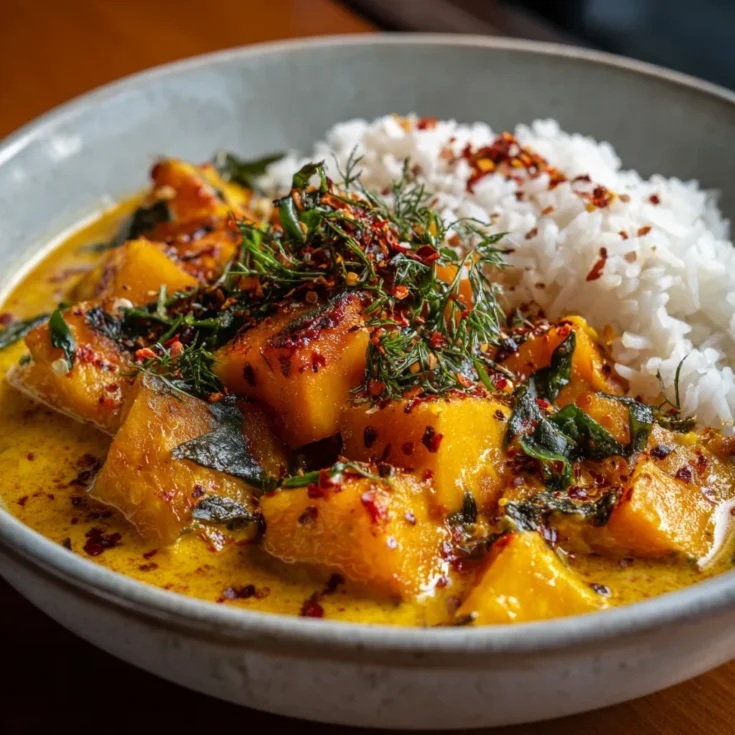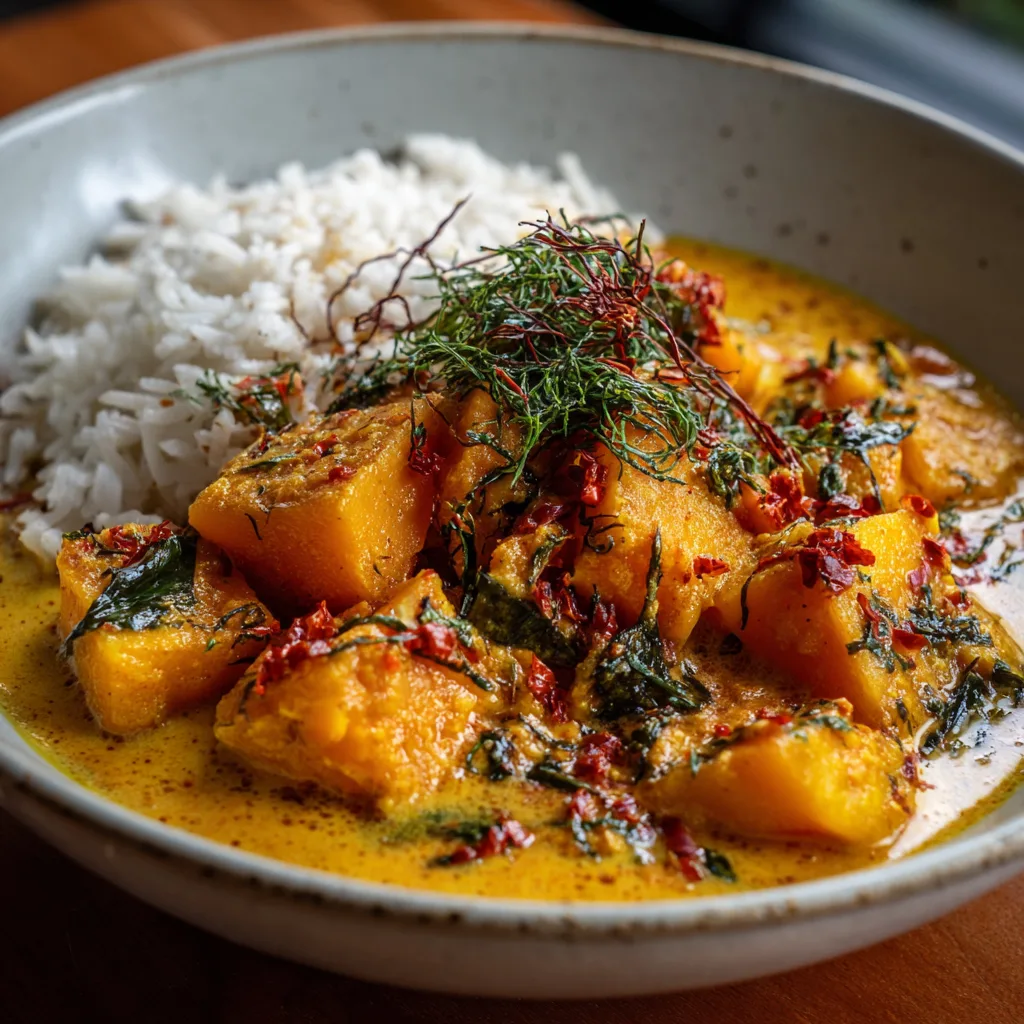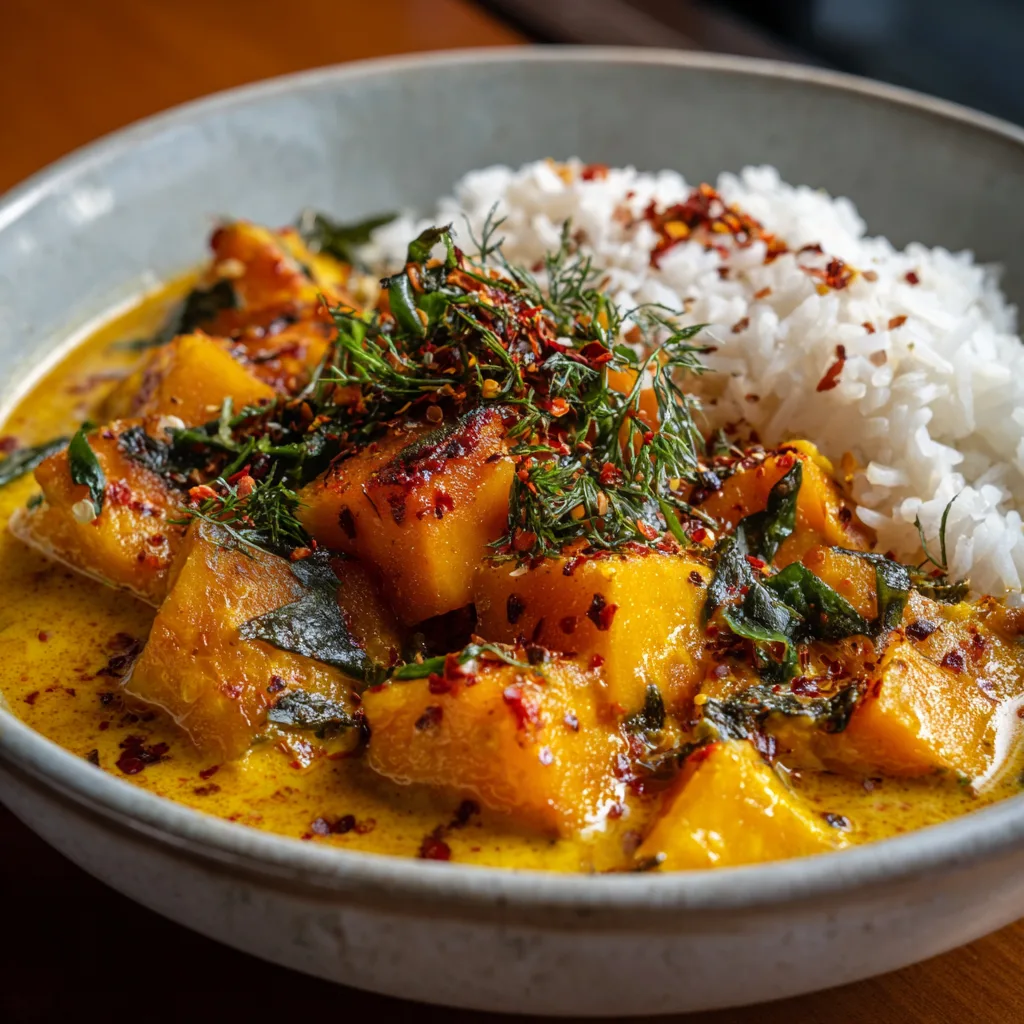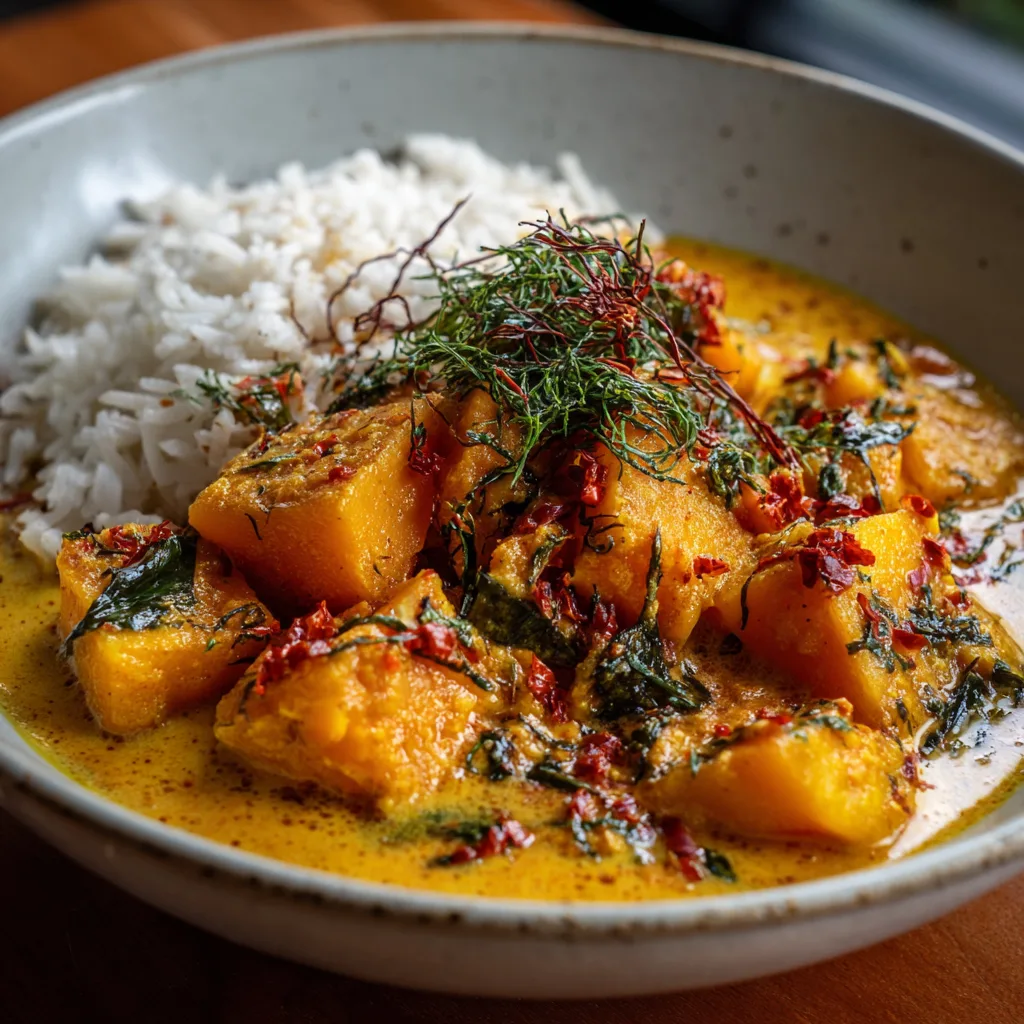One-Pot Low Carb Pumpkin Curry – A Delicious and Healthy Comfort Food
Pumpkin curry is a vibrant, flavorful dish that blends creamy textures with aromatic spices. This comforting meal stands out for its rich taste and versatility. Using pumpkin adds a natural sweetness and depth, making the curry both satisfying and nutritious. When prepared as a one-pot dish, it simplifies cooking and cleanup, saving time and effort in busy kitchens. One-pot recipes bring all ingredients together in a single vessel, allowing flavors to meld perfectly while reducing the mess. This approach suits anyone seeking convenience without sacrificing taste.
Choosing a low-carb version of pumpkin curry makes this classic dish even more appealing. Low-carb meals support better blood sugar control, aid weight management, and boost energy levels by reducing insulin spikes. They fit well within popular eating plans such as keto, paleo, and diabetic-friendly diets. This article will guide you through crafting a wholesome, one-pot pumpkin curry that is both low in carbs and packed with flavor. You’ll discover key ingredients, cooking techniques, health benefits, and practical tips to create your own delicious version.
What Makes This Pumpkin Curry Low Carb?
Pumpkin naturally contains carbohydrates, but fewer than many other squashes. Its moderate carb content makes it suitable for low-carb recipes when combined with the right ingredients. To keep the curry low carb, recipes avoid high-starch vegetables like potatoes and sweet corn. Instead, they focus on pumpkin, low-carb vegetables, and healthy fats such as coconut milk. Sugar and flour-based thickeners are also left out or replaced with alternatives.
Low-carb diets help manage weight, stabilize blood sugar, and reduce cravings. For keto enthusiasts, this pumpkin curry offers a flavorful way to meet daily fat and protein goals. Paleo followers benefit from whole-food ingredients free from processed sugars. Diabetics gain from controlled carbohydrate intake while still enjoying a satisfying meal. This curry proves you don’t need carbs to enjoy rich, comforting food.
Main Ingredients in One-Pot Low Carb Pumpkin Curry: Flavor and Nutrition
Pumpkin forms the heart of this curry, offering a unique sweetness and vibrant color. Varieties like sugar pumpkin or kabocha squash work best for their creamy texture and balanced flavor. Nutritionally, pumpkin provides fiber, vitamins A and C, and antioxidants while maintaining a moderate carbohydrate level, making it perfect for low-carb dishes.
Coconut milk lends a rich, velvety consistency to the curry. It contains healthy medium-chain triglycerides (MCTs) that support energy and fat metabolism. This dairy-free alternative also enhances the dish’s tropical aroma and smooth mouthfeel, making every bite indulgent yet wholesome.
Protein adds substance and variety to the curry. Tofu suits vegetarians and offers plant-based protein with minimal carbs. Chicken or shrimp provides lean animal protein without adding many carbohydrates. Chickpeas add fiber and nutrients but should be used sparingly, as they carry higher carbs compared to other options.
Low-carb vegetables like spinach, bell peppers, and zucchini add freshness and texture. These veggies bring essential vitamins and minerals while keeping the dish light and satisfying. Their natural flavors complement the pumpkin’s sweetness and balance the curry’s richness.
Essential Spices and Flavorings for a Healthy Low-Carb Pumpkin Curry
A blend of spices forms the soul of this curry. Curry powder combines turmeric, cumin, coriander, and other aromatic spices to create a warm, complex flavor profile. Turmeric stands out for its anti-inflammatory and antioxidant benefits, helping support overall health. Cumin adds earthiness and aids digestion, while coriander offers subtle citrus notes. Fresh ginger and garlic boost immunity and add a pungent zing that enlivens the dish.
These spices not only enhance taste but also contribute valuable health properties. Together, they help improve metabolism and reduce inflammation, making the curry both tasty and nourishing.
Low-Carb Substitutions for Traditional Curry Ingredients
Traditional pumpkin curry recipes often include high-carb ingredients such as potatoes or sugar to enhance thickness and sweetness. To keep carbs low, these are replaced or omitted. Instead of potatoes, cauliflower rice or shirataki noodles serve as excellent low-carb side options that absorb curry flavors without adding unnecessary starch.
Sugar, commonly added to balance spice, can be substituted with natural, zero-calorie sweeteners like stevia or erythritol. These alternatives maintain sweetness while keeping blood sugar stable.
By choosing thoughtful substitutions, this one-pot pumpkin curry delivers all the comforting tastes of a classic curry without excess carbohydrates. This makes it ideal for those following ketogenic, paleo, or diabetic-friendly eating plans.
Why Choose One-Pot Cooking for Pumpkin Curry? Time-Saving, Flavorful, and Efficient
One-pot cooking offers a simple and efficient way to prepare pumpkin curry. By using just one pot, you save valuable time on both cooking and cleaning. This method eliminates the need for multiple pans and reduces kitchen clutter, making it ideal for busy days or novice cooks.
Layering ingredients in one pot enhances flavor development. As spices, vegetables, and proteins cook together, their tastes meld, creating a rich and harmonious dish. The slow simmer allows the pumpkin to soften perfectly, absorbing spices and creamy coconut milk.
One-pot cooking also conserves energy. Using a single burner on low to medium heat means less electricity or gas consumption. This eco-friendly approach keeps your kitchen cooler and lowers your utility bills, all while delivering maximum flavor in minimal time.
Step-by-Step Cooking Process Overview for One-Pot Low Carb Pumpkin Curry
Begin by preparing the pumpkin and vegetables. Peel and cube the pumpkin into bite-sized pieces. Chop bell peppers, spinach, or any other low-carb veggies you prefer. This prep work ensures even cooking and quick assembly.
Next, sauté the aromatics. Heat oil in your pot and add chopped onions, minced garlic, and grated ginger. Cook until they soften and release their fragrant aroma. Then, add your dry spices—curry powder, turmeric, cumin, and coriander—and stir for about one minute to toast them lightly.
Add the pumpkin and vegetables to the pot, stirring to coat them evenly with the spices. Pour in coconut milk and bring the mixture to a gentle simmer. Cover and cook until the pumpkin turns tender, usually 15 to 20 minutes.
Finally, incorporate your choice of protein, whether tofu, chicken, or shrimp. Add spinach or other leafy greens at this stage and cook for an additional five minutes. Adjust seasoning with salt and pepper, then garnish with fresh herbs before serving.
Tips for Perfect Texture and Flavor in Your Pumpkin Curry
Avoid overcooking the pumpkin to prevent it from becoming mushy. Check tenderness by piercing with a fork; it should be soft but still hold its shape. Maintain medium-low heat during simmering to allow gradual cooking without breaking down the pumpkin too much.
Balance spices and creaminess by tasting as you go. If the curry feels too thick, add a splash of water or broth to loosen it. For extra richness, stir in a bit more coconut milk. Conversely, if the curry is too thin, simmer uncovered briefly to thicken.
Adjust seasoning gradually. Curry should have a layered depth—warm spice notes balanced by creamy coconut and a touch of salt. Fresh herbs like cilantro or mint brighten the flavor just before serving.
Variations and Customizations for Every Taste and Diet
This one-pot pumpkin curry adapts well to vegan and vegetarian diets by using tofu or chickpeas as protein sources. For meat lovers, chicken or shrimp add a satisfying boost without increasing carbs.
Customize heat levels to suit your palate. Add mild chili flakes for a gentle warmth, or increase the amount for a spicy kick. Fresh chili peppers or cayenne powder work well here.
Incorporate seasonal vegetables like kale, zucchini, or bell peppers to keep the dish fresh and varied. You can also experiment with protein swaps or add nuts like cashews for extra texture. This flexibility makes the recipe perfect year-round and for all tastes.
Nutritional Breakdown of One-Pot Low Carb Pumpkin Curry
One-pot low carb pumpkin curry offers a balanced blend of macronutrients tailored for healthy eating. The pumpkin provides moderate carbohydrates, mainly from fiber and natural sugars, helping maintain steady blood sugar levels. Healthy fats come from coconut milk, supplying medium-chain triglycerides (MCTs) that promote energy and fat metabolism. Protein varies depending on your choice—whether tofu, chicken, or shrimp—adding essential amino acids to support muscle health.
Fiber from pumpkin and low-carb vegetables like spinach and bell peppers aids digestion and keeps you feeling full longer. The abundance of vitamins, especially vitamin A from pumpkin, supports eye health and immune function. This nutrient-rich profile makes the curry both nourishing and satisfying while aligning with low-carb goals.
Health Benefits of Pumpkin and Curry Spices
Pumpkin is rich in antioxidants like beta-carotene, which fight free radicals and reduce oxidative stress. Its anti-inflammatory properties help protect against chronic diseases. The spices in the curry add powerful health benefits: turmeric contains curcumin, a compound known for its anti-inflammatory and antioxidant effects. Ginger soothes digestion, reduces nausea, and supports immune defenses.
Cumin and coriander further promote digestion and can help regulate blood sugar. Together, these ingredients create a dish that not only delights the palate but also supports overall health. Regular consumption may improve inflammation levels and boost the immune system, making this curry a wellness-enhancing meal choice.
Suitability for Special Diets: Keto, Paleo, Gluten-Free, and More
This pumpkin curry fits well within keto and paleo lifestyles due to its low carbohydrate content and focus on whole, natural ingredients. The use of coconut milk provides healthy fats without dairy, making the dish suitable for dairy-free eaters.
It naturally avoids gluten, making it a safe option for those with gluten sensitivities or celiac disease. The recipe can be adapted for allergen-friendly diets by swapping out proteins or avoiding nuts and soy, depending on individual needs.
By carefully selecting ingredients, this one-pot pumpkin curry offers a flexible, nutritious meal option that meets diverse dietary requirements while remaining flavorful and satisfying.
FAQs About One-Pot Low Carb Pumpkin Curry
What is the best type of pumpkin for curry?
Sugar pumpkins and kabocha squash are ideal for curry. They have a creamy texture and natural sweetness that balance spices well. Avoid large carving pumpkins, as they tend to be watery and bland.
Can I freeze leftover pumpkin curry?
Yes, freezing leftover pumpkin curry works well. Store it in an airtight container for up to three months. When reheating, thaw in the fridge overnight and warm gently on the stove to maintain texture and flavor.
How do I make this curry spicier without adding carbs?
To add heat without extra carbs, use fresh chili peppers, chili powder, or cayenne pepper. These spices add intense flavor without impacting carbohydrate content.
Is coconut milk necessary, or can I substitute it?
Coconut milk gives the curry its creamy richness and healthy fats. You can substitute with almond milk or cashew cream, but the texture and flavor will differ slightly. Avoid dairy milk to keep it dairy-free and low carb.
How long does this curry keep in the fridge?
Store the curry in an airtight container in the refrigerator for 3 to 4 days. Reheat thoroughly before serving. Fresh herbs should be added just before eating to retain flavor.
Can this recipe be made in an Instant Pot or slow cooker?
Yes, both Instant Pot and slow cooker methods work well. Use the sauté function to cook spices and aromatics first, then add remaining ingredients. Cook on low for 4-6 hours or high for 2-3 hours in a slow cooker. Adjust liquid amounts slightly if needed.
What are low-carb side dishes to serve with pumpkin curry?
Cauliflower rice, zucchini noodles, and shirataki noodles make excellent low-carb sides. You can also serve with steamed greens or a crisp salad to keep the meal light and balanced.
One-Pot Low Carb Pumpkin Curry – Creamy, Spicy & Healthy

This creamy, flavorful pumpkin curry is made entirely in one pot, offering a healthy low-carb meal full of rich spices and nutrients. Easy to prepare and highly customizable, it fits a variety of dietary needs while delivering comforting taste.
Ingredients
- 3 cups diced pumpkin (peeled and cubed)
- 1 can (13.5 oz) full-fat coconut milk
- 1 medium onion, finely chopped
- 2 cloves garlic, minced
- 1-inch piece ginger, grated
- 1 tbsp curry powder
- 1 tsp turmeric powder
- 1 tsp cumin powder
- 1 bell pepper, sliced
- 2 cups spinach leaves (optional)
- 1 tbsp olive oil or coconut oil
- Salt and pepper, to taste
- Protein option: 1 cup cubed tofu or cooked chicken (optional)
- Fresh cilantro for garnish
Instructions
Notes




